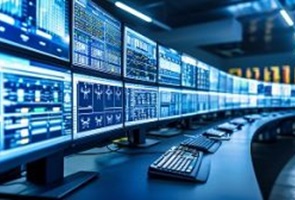
Instrumentation and control systems are critical for modern manufacturing and processing facilities because they create and employ precise monitoring and control of production variables. They include sensors, transmitters, controllers, and displays in conjunction with automation. They also collect real-time data from variables, such as temperature, pressure, flow, level, and quality. Technicians use this data to make informed decisions and take necessary preventative actions. Contact ITI Technology College today for more information.
Instrumentation and control systems enhance performance efficiency, and product quality, and improve workforce safety by automating dangerous tasks. With these controls, high standards of operations and products can be maintained, performance can be analyzed, and optimization can be reached. Other benefits include reducing downtime, maintenance costs, the time from conception of products to distribution, and markets.
Components Of Manufacturing Instrumentation And Control Systems
Manufacturing and industrial instrumentation and control systems include the devices, computers, equipment, machinery, and automation to achieve production standards. With them, you measure, monitor, and control variables and processes to achieve efficiency, safety, and quality of operations. Instrumentation and controls include these technologies:
- Calibration Equipment ensures the accuracy and reliability of measurement devices to meet national or international standards. This equipment can be automated with software to adjust and align devices to meet those standards and compliance regs.
- Data Acquisition Systems collect and store data from sensors and instruments to analyze, monitor, and control industrial processes.
- Human-Machine Interfaces are tools that let technicians interact with and control devices, equipment, and processes. They can visualize real-time data, coordinate with control functions, and support diagnostic tasks.
- Instrumentation Control Systems use feedback from sensors to regulate and automate processes. Programmable Logic Controllers (PLCs) use algorithms to manage manufacturing processes.
- Measurement Devices position encoders to accurately measure variables within industrial processes.
- Safety Systems help prevent or mitigate dangerous events by automatically taking corrective actions in response to unusual conditions and variables. The result is improved safety, efficiency, and productivity.
- Sensors and Transducers convert physical variables into electrical signals that are measured and processed by control systems.
- Signal Conditioning equipment uses signals from sensors to improve accuracy, compatibility, and stability within control systems.
Applications Of Manufacturing Instrumentation, Control Systems, And Automation
 Instrumentation, control systems, and automation empower businesses to leverage new technologies and data insights to thrive in their industries with these applications.
Instrumentation, control systems, and automation empower businesses to leverage new technologies and data insights to thrive in their industries with these applications.
- Energy Management systems monitor and optimize energy consumption to keep costs low. Energy-intensive processes can be identified to reduce waste and improve efficiency.
- Predictive Maintenance is achieved by continuously monitoring equipment and machinery condition parameters to predict maintenance strategies. Early detection of possible problems minimizes downtime and helps prevent equipment failures.
- Process Control improvements let technicians monitor and regulate everyday variables, such as flow, pressure, and temperature to maintain optimal processing conditions.
- Safety and Environmental monitoring uses alarms and safety interlocks to trigger automatically in case of dangerous or hazardous waste conditions. This monitoring protects workers and mitigates environmental risks.
- Quality Assurance is optimized when instrumentation monitors product quality to ensure it meets company specifications and regulatory standards. Sensors and feedback loops adjust process variables in real time to maintain uniformity.
|
“Instrumentation and control systems are critical for modern manufacturing and processing facilities because they create and employ precise monitoring and control of production variables.” |
Trends And Innovations Driving Instrumentation, Control Systems, And Automation
The evolution of instrumentation, control systems, and automation is driven by new sensor technology, data analytics, and technician training. The resulting emerging trends include these:
- Artificial Intelligence (AI) and Machine Learning (ML) analyze vast amounts of data to identify patterns and optimize control strategies to enhance performance.
- Cybersecurity provides protection against cyber criminals who can steal data or process secrets and cause production breakdowns.
- Edge Computing allows technicians and plant operators to work with data processing and analysis for local manufacturing at the sensor or controller level.
- Internet Of Things (IoT) integrates actuators, sensors, and control systems into seamless connectivity and remote monitoring to improve production efficiency and decision-making.
- Wireless Instrumentation sensor networks eliminate a lot of costly and cumbersome wiring. Placing flexible and cost-effective sensors in remote or hazardous environments is effective.
Instrumentation And Control Benefits
 Instrumentation and control systems are driving modern manufacturing with their advanced capabilities. Data collected by them provide valuable insights into equipment and process performances and help technicians understand:
Instrumentation and control systems are driving modern manufacturing with their advanced capabilities. Data collected by them provide valuable insights into equipment and process performances and help technicians understand:
- How to make faster and smarter decisions
- Monitoring proactive maintenance at higher levels
- Troubleshooting issues before they escalate
- How to fine-tune processes for increased efficiency
- Improve overall quality of products and production
- How to better control equipment and machinery downtime
Earn An Associate Degree Education To Launch Your Career
You will increase your chances of obtaining a good entry-level job by earning an Associate of Occupational Studies (AOS) Degree in Instrument and Control Systems Technology. Let one of our admissions representatives show you how.
For more information about graduation rates, the median debt of students who completed the program, and other important information, please visit our website:https://iticollege.edu/disclosures/




